
Castles of Great Britain

Castles of Great Britain
- Great Britain is home of hundreds of castles, some still lived in, some reduced to little more than lumps and bumps in the land-scape. Many of them have been the scene of great historical events and all have often bloody and grim stories to tell.

Castles of Great Britain
- Great Britain is full of castles and fortifi-cations to explore. Some are large, famous and easy to find, while others are almost forgotten ruins. There are over 800 castles in Great Britain.

Glamis Castle
- The England castles features are some of the most famous in world as well as a major tourist attraction.

Hampton Court Castle
- Castles have been an important part of life in England since the early days of the Norman conquerors, and have served as defensive strongholds, homes, and historic sites throughout the years .

The Tower
- The Tower of London was built by William the Conqueror to protect and control the city of London.

White Tower
- The Tower has been used as fortress, a palace, and a prison. It has housed the Royal Mint, the Public Records, and the Royal Observatory. And from the 13th century until 1834 it housed the Royal Menagerie.

The Tower
- For centuries it was the arsenal for arms and armor. And, since it is one of the strongest fortresses in England, it has guarded and continues to guard the crown jewels .

In fact the Tower was no longer used as a royal residence, except before coronations
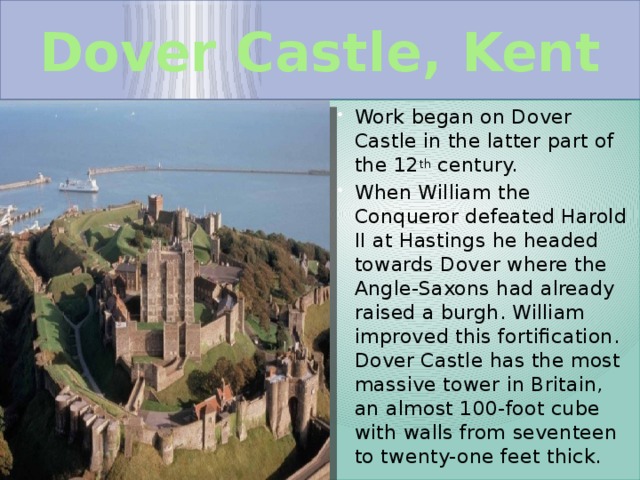
Dover Castle, Kent
- Work began on Dover Castle in the latter part of the 12 th century.
- When William the Conqueror defeated Harold II at Hastings he headed towards Dover where the Angle-Saxons had already raised a burgh. William improved this fortification. Dover Castle has the most massive tower in Britain, an almost 100-foot cube with walls from seventeen to twenty-one feet thick.

Hidden deep inside the famous White Cliffs, and under Dover Castle,
- are a vast network of underground tunnels, first constructed in the Middle Ages. However, during the Napoleonic Wars, these tunnels were greatly extended to provide barracks for the great numbers of soldiers called to Dover Castle to prepare for invasion from the French. This massive underground complex also played an important role in the Second World War, and it is absolutely fascinating to 'relive' these moments today.

Dover is still an important and
bustling centre of commerce, and today hundreds of visitors overawed by its size and dominance, who are eager to discover some of the fascinating secrets held within its imposing walls.

Windsor Castle
- Windsor Castle is the most famous of all castles in England. Still a principal home of the British royal family, the sprawling structure is the largest and oldest residential castle in the world. It has been the site of a royal residence for almost 1,000 years, since the time of William the Conqueror.

The history of Windsor Castle
- William’s fortifications consisted of a wooden structure atop an artificial hill. Throughout the history of Windsor Castle other monarchs have put their own stamp on the castle, but the round hill and outer walls are still in the same position as in William’s day. Windsor’s strategic position, 20 miles west of London near the banks of the River Thames, made it an important Norman fortress.

Windsor is a residence of the royal family
- Windsor remains a primary residence of the royal family, but much of it is now open to the public. Sights on a Windsor Castle tour include the daily changing of the guard, a more elaborate and exciting affair here than at Buckingham Palace. The public rooms contain a wealth of painting, decorative ceiling designs, and antique furniture.
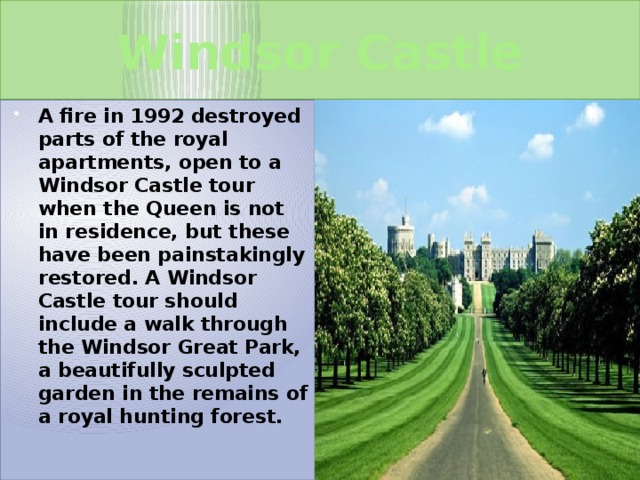
Windsor Castle
- A fire in 1992 destroyed parts of the royal apartments, open to a Windsor Castle tour when the Queen is not in residence, but these have been painstakingly restored. A Windsor Castle tour should include a walk through the Windsor Great Park, a beautifully sculpted garden in the remains of a royal hunting forest.

Warwick Castle

Warwick Castle was founded in 1068 and was rebuilt and updated a number of times.
- Today it combines castle ruins, largely of the fourteenth century with one of the finest great houses in England. Two small projecting towers, which date to the late fifteenth century are said to have built as artillery platforms. Warwick Castle rises like a precipice above the River Avon.

- The first castle consisted of a huge mound of earth topped with a wooden fort. In the late fourteenth century the several major changes were made to the castle including the great hall and domestic ranges, a water gate and improvements to the main gatehouse and the barbican in front of it.
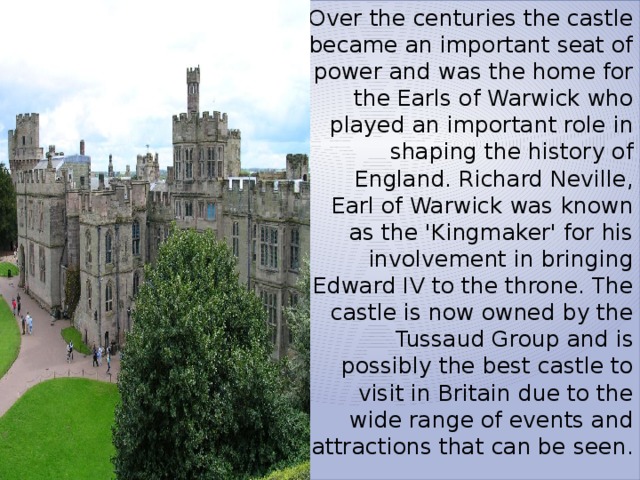
- Over the centuries the castle became an important seat of power and was the home for the Earls of Warwick who played an important role in shaping the history of England. Richard Neville, Earl of Warwick was known as the 'Kingmaker' for his involvement in bringing Edward IV to the throne. The castle is now owned by the Tussaud Group and is possibly the best castle to visit in Britain due to the wide range of events and attractions that can be seen.

Bodiam Castle
- Bodiam Castle is situated beside the River Rother in East Sussex and was built in the late 14th century by a veteran of King Edward III's wars with France, originally as a coastal defence. In 1385, Sir Edward Dalyngrygge was given permission to fortify his house against invasion from France, but then decided to build a new stone castle a short distance away from the house.

Bodiam Castle
- Bodiam Castle has a notable symmetry and is surrounded by a wide moat. The moat was created from an artificial lake which, in turn, originated from allowing the river to flow into a rectangular area of marshy land.

The construction of Bodiam Castle appears to have been a perfect combination of medieval defence strategies and remarkably comfortable accommodation, thus creating a magnificent fortified building in an idyllic country side.

Leeds Castle
- Leeds Castle, acclaimed as the most romantic castle in England, is located in south-east England, built on two adjacent island in the river Len.

- Leeds Castle was originally a manor of the Saxon royal family possibly as early as the reign of Ethelbert IV ( 856-860). The first castle was an earthwork enclosure whose wooden palisade was converted to stone and provided with two towers along the perimeter. This is now vanished. Traces of arches in a vault thought to be Norman were found at the beginning of this century.
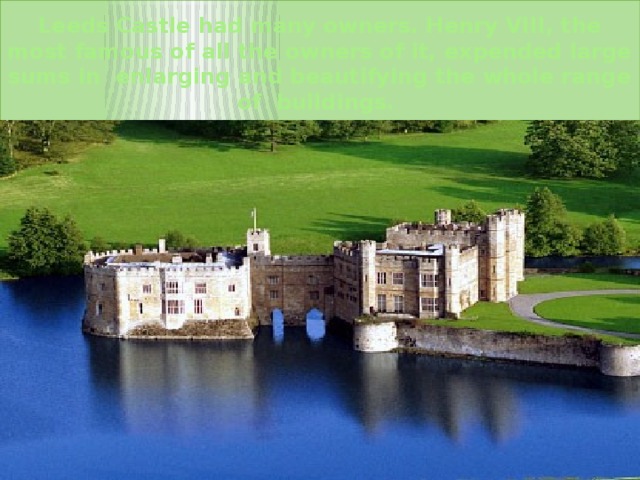
Leeds Castle had many owners. Henry VIII, the most famous of all the owners of it, expended large sums in enlarging and beautifying the whole range of buildings.

Leeds Castle
- Leeds has been constantly inhabited and rebuilt since then. Most of the castle today is the result of the nineteenth-century reconstruction and addition. In 1926 Leeds was bought by Mrs. Wilson-Filmer, known as Lady Baillie. Immediately she began the restoration of the castle that took her over 30 years to leave it as it stands today.

CASTLES WITH GHOSTS
What story would
be complete
without a haunted
castle. Here is some of the castles
that are reportedly
haunted in
England.

- Dover Castle, Kent Dover Castle is associated with numerous ghosts and strange sounds. In the King's bedroom, the lower half of a man has been seen walking through the doorway. The specter of a woman dressed in a red dress has been seen at the west stairway of the keep. The sounds of a creaking doorway opening and closing where a door used to be, but isn't anymore, have been heard.

Berry Pomeroy Castle
- The castle, now a romantic ruin, is reputed to be one of the most haunted in the British Isles. It has numerous legends associated with it.

The most famous among ghosts are White Lady and Blue Lady .
- The White Lady haunts the dark dungeons, and rises from St Margaret's Tower to the castle ramparts. According to the legend she is the spirit of Margaret Pomeroy, who was imprisoned in the dungeons by her sister Eleanor. Eleanor was jealous of both her beauty and her affections for the man she had designs upon. Margaret slowly starved in the dungeons.

The Blue Lady is not confined to specific areas of the castle and
- is supposed to lure people into parts of the ruin. Traditionally she is seen as the ghost of the daughter of one of the Norman Lords of the castle. She was raped by her father, who then strangled the resulting child in one of the upper rooms.
- Sometime you can hear baby`s cry into the ruins.

Featherstone Castle
Just about in the geographical centre of Britain near to the small town of Haltwhistle in Northumberland can be found the picturesque Featherstone Castle. The oldest part of the existing castle dates back to the 1400s.

Featherstone Castle, Northumberland
- The castle is associated with a ghostly bridal party. The story goes that Abigail (daughter of the owner of this castle)was in love with a boy from the local Ridley family but that she had to marry the son of a Baron because of her father Baron Featherstonehaugh.

The wedding party left for the "traditional hunt" after the wedding, leaving the baron behind to make arrangements for the banquet.
- When the party didn`t return by midnight, the baron began to fear the worst. Sitting alone at the table, he heard horses crossing the drawbridge. The door opened and the party entered. But, they made no sound and passed through furniture. The wedding party had been ambushed and killed. On the anniversary of the wedding, the party can still be seen heading towards the castle.

Lowther Castle, Cumbria
- This castle, haunted by Sir James Lowther. He was very unhappy with a pre-arranged marriage, and fell in love with a farmer's daughter. When she suddenly grew ill and died, Sir James refused to believe she was dead and left her on the bed. She was finally moved and placed in a coffin with a glass lid, which he set in a cupboard where he could look at her.

Lowther Castle, Cumbria
She was finally buried, and Sir James died unloved and unmourned. At his funeral his coffin began to sway as it was lowered into the ground. His spectral coach and ungroomed horses can be seen being driven through the parklands of the castle .
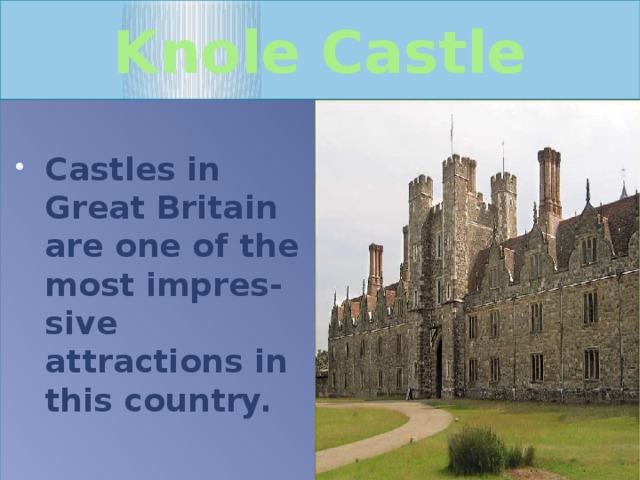
Knole Castle
- Castles in Great Britain are one of the most impres-sive attractions in this country.

The End

 Получите свидетельство
Получите свидетельство Вход
Вход












 Castles of Great Britain (4.29 MB)
Castles of Great Britain (4.29 MB)
 0
0 1365
1365 36
36 Нравится
0
Нравится
0


